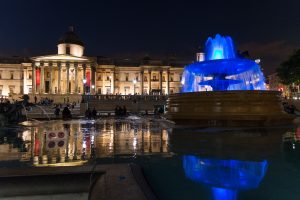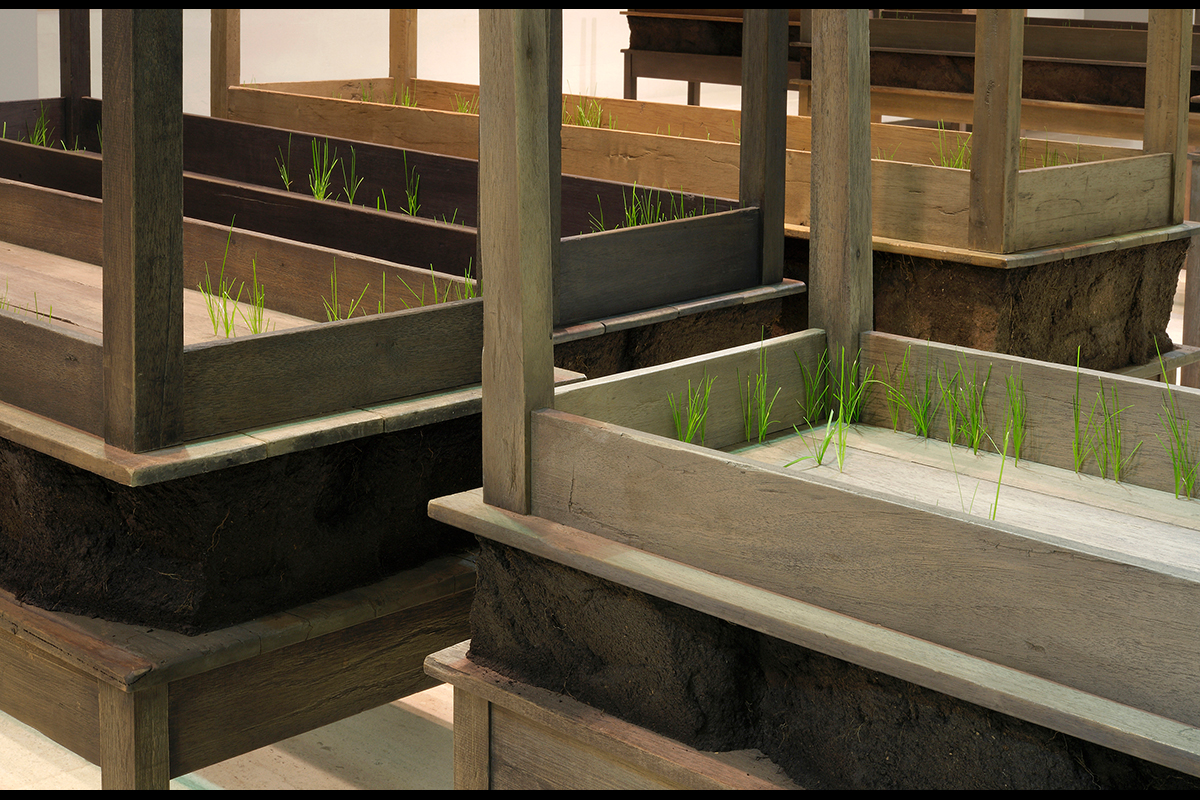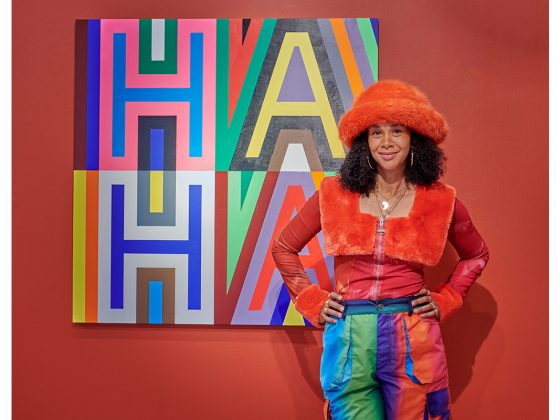A TRIBUTE TO THE GREAT SURREALIST ARTIST VICTOR BRAUNER
IN HIS NATIVE ROMOMANIA

The Palladist or Composition on the theme of the Palladist, [1943] – Oil on canvas 130 x 162 cm Purchased, 1974 Collection Centre Pompidou, Paris Musée national d’art moderne – Centre de création industrielle ©Copyright of artwork : © Adagp, Paris ©Photo credit : (c) Centre Pompidou, MNAM-CCI/Jean-François Tomasian/Dist. RMN-GP ©Courtesy: ARC 2023
On the occasion of the «Timisoara European Capital» event, a retrospective Victor Brauner has been organized for the beginning 2023 to pay tribute to this great artist in his native country.

Born in 1903 in Piatra Neamț (Moldova), Victor Brauner actively participated from the 1920s in the Bucharest avant-garde of which he became one of the main representatives. His conversion to Surrealism took place gradually between the first stay (1925-1926) and the second stay in Paris (1930-1935) of the artist, who joined the movement of André Breton in the autumn of 1933. Following an accident in 1938, Brauner lost an eye and became, for the surrealists, the “visionary” painter, capable of premonition. This enucleation had been painted in his Self-Portrait in 1931, seven years earlier.

©Courtesy: ARC 2023
Victor Brauner, who settled permanently in France in 1938, is one of the greatest artists of surrealism. He is also an artist apart in the story of art with an original work, complex, erudite, full of humor and inventions, and nourished by his Romanian origins, the most secret esotericisms, German Romantics, parietal art and primitive arts.
This exhibition benefits from an exceptional loan from the Centre Pompidou (Paris) with about forty works, which should be completed by a dozen works from the museums of Marseille and Saint-Etienne, as well as about twenty works preserved in Romania in museums and private collections.
This retrospective will thus be able to present the entire career of the artist, from the 1920s to the 1960s, and his creation according to various media (painting, drawing, object, sculpture).

©Courtesy: ARC 2023
Even if some of Brauner’s artworks (especially of the beginning of his production) are present in museum and private collections in Romania, Brauner, recognized internationally (in France, Germany, Italy, the United States, …), is still too little known in his native country. That is why this retrospective – the first exhibition dedicated to this great artist in a museum in Romania – is a very important event.
“The Inventions and Magic”
THE EXHIBITION

Wax scraped on cardboard, incisions blackened with ink -17,9 x 14,9 cm Legacy of Mrs. Jacqueline Victor Brauner in 1986 Collection Centre Pompidou, Paris Musée national d’art moderne – Centre de création industrielle ©Copyright of artwork : © Adagp, Paris
In the eleven halls located on the second floor of the Baroque Palace of the National Museum of Art Timișoara, the exhibition presents nearly seventy works by Victor Brauner, from the 1920s to the 1960s, according to the different media of his production (painting, drawing, engraving, sculpture). The beginnings of the artist’s creation are notably shown thanks to emblematic pieces from museum and private collections in Romania, supplemented by an exceptional loan from the Centre Pompidou (around forty works, as well as around twenty archival documents), and loans from the museums of Saint-Étienne and Marseille, exhibited for the first time in Romania. The life and work of Victor Brauner are intrinsically linked, which is why the proposed route is essentially chronological. Each hall presents a text and most often the reproduction of a portrait of the artist, such as that by Man Ray (circa 1933-1934, Paris, Centre Pompidou).

©Courtesy: ARC 2023
HALL 1
BEGINNINGS IN BUCHAREST
Between 1920 and 1925, Brauner engaged in various artistic experiments in his paintings, in connection with the European avant-gardes spread in Romania: cubism, expressionism, dadaism, and constructivism.
HALL 2
THE ENCOUNTER WITH THE SURREALIST UNIVERSE
Victor Brauner’s «conversion» to surrealism took place gradually, between his first stay (1925) and his second stay (1930) in Paris. Paintings from the late 1920s feature twilight landscapes brought to life by fantastical creatures.
HALL 3
DRAWINGS FROM THE 1920´ S
The artist’s graphic art in the 1920s is thematically and formally linked to his painting, for example: Projet pour ‘l’orateur’ / Project for the «Orator» (1929, Paris, Centre Pompidou). Animals and poems are also summoned up in playful compositions.

China ink on paper – 21,5 x 34 cm Donated by Mrs. Jacqueline Victor Brauner in 1974 Collection Centre Pompidou, Paris Musée national d’art moderne – Centre de création industrielle ©Copyright of artwork : © Adagp, Paris ©Photo credit : (c) Centre Pompidou, MNAM-CCI/Philippe Migeat/Dist. RMN-GP
HALL 4
THE SURREALIST ADVENTURE IN PARIS
The painter met André Breton in 1933 and officially joined the surrealist
movement. Three major works of his production are exhibited, testifying to
dark prophetic visions: the premonition of his future enucleation in 1938 in Autoportrait / Self-Portrait ([1931], Paris, Centre Pompidou), important to Breton’s «objective hazard», as well as the threat of the rise of nationalisms and fascism with the disfiguration of the portrait of Hitler ([1934], Paris, Centre Pompidou) and with the invention of the character of Monsieur K, figure of the father and the dictator, both grotesque and monstrous, in L’Étrange cas de Monsieur K. / The Strange Case of Monsieur K. (1933, Museum of Modern and Contemporary Art of Saint-Étienne).

Oil on wood 22 x 16,2 cm – Legacy of Mrs. Jacqueline Victor Brauner in 1986 Collection Centre Pompidou, Paris Musée national d’art moderne – Centre de création industrielle ©Copyright of artwork : © Adagp, Paris ©Photo credit : (c) Centre Pompidou, MNAM-CCI/Philippe Migeat/Dist. RMN-GP
HALL 5
BRAUNER, THE DRAWER
These drawings from the 1930s confirm what an extraordinary drawer Victor Brauner is. Following the approach conducive to automatism generated by surrealism, the artist demonstrates inventions both in the motifs and in a concise technique and composes chimerical and hybrid creatures, according to enigmatic and erotic figures.

Oil on wood (oak) -14 x 18 cm -Donated by Mrs. Jacqueline Victor Brauner in 1982 Collection Centre Pompidou, Paris Musée national d’art moderne – Centre de création industrielle ©Copyright of artwork : © Adagp, Paris ©Photo credit : (c) Centre Pompidou, MNAM-CCI/Service de la documentation photographique du MNAM/Dist. RMN-GP
HALL 6
RETURN TO ROMANIA
Victor Brauner, confronted with fascism and anti-Semitism, associates in five paintings of very small formats the memory of the metaphysical landscapes of Giorgio De Chirico and the anatomical deformations of Salvador Dalí, to show the desolation which reigns in his country, not without a fierce humour. In these paintings (for example Sur le motif, 1937, Paris, Centre Pompidou), the motif of the eye also appears obsessively.

Stable unstable, plain of Théus, April 1942 – Oil on canvas – 73 x 54 cm – State purchase, 1951 Allotment, 1951 Collection Centre Pompidou, Paris Musée national d’art moderne – Centre de création industrielle Copyright of artwork : © Adagp, Paris ©Courtesy: ARC 2023
HALL 7
IN FRANCE, DURING THE WAR
The series of Lycanthropes, populated by Chimeras, painted until 1939, gives way to incessant metamorphoses where the artist multiplies the motif of the female nude. Condemned to clandestinity from 1942 and plunged into material and relational deprivation, Brauner profoundly renewed his art by using wax (Sans titre / Untitled, 1945, Paris, Centre Pompidou) and moving on to sculpture. This hall presents, among other things, the painting Stable instable, plaine de Théus / Stable unstable, plain of Théus (1942, Paris, Centre Pompidou), selected for the poster of the exhibition and the cover of the catalogue (Image above), which evokes the metamorphosis of a sleepwalker whose hair is transformed into a fantastic animal. The two sculptures exhibited, Signe ([1942-1945], Marseille, Musée Cantini) and Tot în Tot (1945, Paris, Centre Pompidou), exceptional in the sculptural production of the artist, which includes only five works, portrayed, with the double head, the sighted artist and his mythical universe.

Bronze and gold paint, lost-wax – 37 x 9,02 x 29,02 cm Donated by M. Alexander Iolas in 1980 Collection Centre Pompidou, Paris Musée national d’art moderne – Centre de ©Copyright of artwork : © Adagp, Paris ©Photo credit : (c) Centre Pompidou, MNAM-CCI/Bertrand Prévost/Dist. RMN-GP
HALL 8
Archival documents are presented, mainly those from the Victor Brauner collection bequeathed by his wife Jacqueline Brauner to the French state in 1986 and kept at the Kandinsky Library (Centre Pompidou). Romanian and surrealist magazines, as well as works by Romanian and French friends of Brauner, dating from the 1920s and 1950s and illustrated by the artist, are among other manuscripts of the painter. In addition to the archives, four etchings by Brauner are on display.
HALL 9
AFTER THE WAR
The artist idealizes previous research on the various esoteric symbols in a
syncretic language of his own invention, synthesizing hybrid figures with stylized forms. One of the important paintings in this room, Totem de la subjectivité blessée II / Totem of Wounded Subjectivity II (1948, Paris, Centre Pompidou) was painted in Switzerland, where Brauner faced the threats of the expulsion of Romanians in an illegal situation in France. Describing this painting, the painter confided in showing «the teeth of the Stalinists [who] wounded little Victor to death and imprisoned him.»

Oil on canvas – 91,5 x 72,7 cm Legacy of Mrs. Jacqueline Victor Brauner in 1986 Collection Centre Pompidou, Paris Musée national d’art moderne – Centre de création industrielle ©Copyright of artwork: © Adagp, Paris ©Photo credit: (c) Centre Pompidou, MNAM-CCI/Jean-François Tomasian/Dist. RMN-GP
HALL 10
BEYOND SURREALISM
In the 1950s and 1960s, Victor Brauner sought to go beyond surrealism without denying it. The exhibited paintings testify to various researches towards a simplification of forms, creating a phantasmagoric and marvelous world. In 1965, the artist painted two distinct series: «Mythology» and «Mother’s Day», including La Mère des Mythes / The Mother of Myths (1965, Paris, Centre Pompidou) which presents a protective and generous figure, bearer of dreams and myths. In this ultimate masterful ensemble, endowed with humor and fantasy, Brauner becomes somewhat the prophet of a world made up of mythologies.

Oil on canvas and painted wood on plywood – 144 x 200 x 3 cm – Purchase from the arrears of the legacy of Jacqueline Victor-Brauner, 1993 In storage since 1996 : Musée de l’Abbaye Sainte-Croix (Les Sables-d’Olonne) Collection Centre Pompidou, Paris Musée national d’art moderne – Centre de création industrielle Inventory number: AM 1993-86 ©Copyright of artwork: © Adagp, Paris ©
HALL 11
ECTICISM AND INVENTIONS
A singular set of works called by the artist «Rétractés» (1951-1952) present the terrors of the inevitable condition of existence. Similar to the paintings of Roberto Matta, Victor Brauner questions existential and sexual psychoanalysis, by painting skeletal figures in full mutation. In the early 1960s, the artist offered an imaginary bestiary, evoking familiar or mythical animals drawn by primitive totems.
- At the back of this hall, a film presents several excerpts from interviews with Victor Brauner made at the end of his life, where he demonstrates his invention of drawing with wax during the war, and where he recounts memories of his life and his personal journey from Romania to France.
- To exit the exhibition, the visitor returns to the tenth hall that exhibits mainly the artist’s latest works. With a scenography signed by Attila Kim, this retrospective wishes to propose an initiatory journey, between Romania and France, led by one of the central figures of international surrealism.

Curated by Camille Morando, this first retrospective of the artist in Romania proposes over 100 paintings, drawings, sculptures, book illustrations, and documents spanning Brauner’s entire career as a surrealist artist of Romanian origin.
– Camille Morando is head of Information and Research on Modern Collections at MNAM-CCI, Centre Pompidou. Professor at École du Louvre (Paris), Mrs. Morando curated the monographic exhibition Victor Brauner, Je suis le rêve. Je suis l’inspiration in 2020 (Paris), and actually the exhibition Victor Brauner: Inventions and magic, in Timișoara, a city in western Romania, wich started on February 17, 2023, during the opening weekend of the European Cultural Capital – Timișoara 2023.
The academic interest of Mrs. Morando in Brauner is an older one, her first contact dating back to her Ph.D. years. In 2002, as a resident at the National Institute of Art History (INHA, Paris), she was entrusted with publishing the Victor Brauner archives with Sylvie Patry, from which the volume Victor Brauner: Écrits et correspondances, 1938–1948 came out (Centre Pompidou/INHA 2005).

©Courtesy: ARC 2023
With over two decades of research behind her, Mrs. Morando is today one of the world’s most renowned experts on Victor Brauner. In 2019, Camille Morando edited and published with Arta Grafica a Victor Brauner monography. It was a collection born from a never happened exhibition but meant as the artist’s first retrospective in his native country. Meanwhile, the volume has become a reference point in the literature on Brauner. At the same time, the idea of a Brauner retrospective in Romania took shape in Timișoara in a particular year for the city and the local cultural life.
By curating the exhibition Victor Brauner: Inventions and Magic in 2023, Camille Morando continues the work of recognition of this great artist in his native country. Her in-depth expertise is an additional promise that the first major Victor Brauner retrospective in Romania will be a success

©Courtesy of The Art Museum of “Gavrila ̆ Simion” Institute for Eco-Museum Research, Tulcea
CATALOGUE
The exhibition “Victor Brauner: Inventions and magic” is accompanied by a bilingual catalogue (Romanian/English), which brings together unpublished texts by specialists (Romanian, French and American) on the artist and on the works exhibited, an analytical biography and biographical notes on the Romanian friends of Victor Brauner.

©Courtesy: ARC 2023
NATIONAL MUSEUM OF ART TIMISOARA
The National Museum of Art Timisoara offers a broad perspective on Banat’s heritage of the past two hundred years, as a result of the confluence of the post-Byzantine Balkan tradition and the innovative language of European Baroque art brought to the region by the Catholic Reformation.
-The event is co-organized by the Centre Pompidou, the Timișoara National Art Museum, the Art Encounters Foundation, and the French Institute in Romania, with the support of the Comité Brauner and the Fondation du Judaïsme Français.

©Courtesy: ARC 2023
The exhibition «Victor Brauner: Inventions and Magic»
THE NATIONAL MUSEUM OF ART TIMIȘOARA
Piața Unirii 1, Timișoara 300085, Roumanie
Open from Wednesday to Sunday:
From 10:00 to 18:00 from February 17 to April 30, 2023
From 13:00 to 21:00 from May 1 to 28, 2023 – (Last Days)













